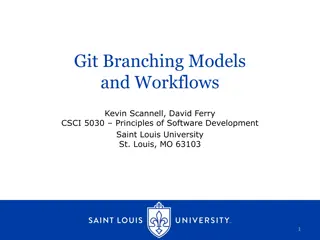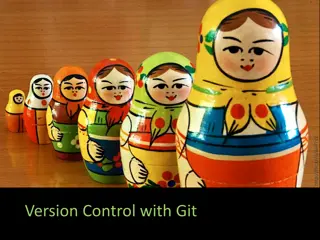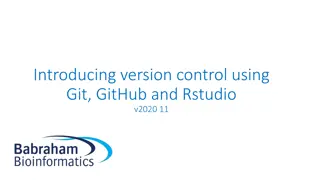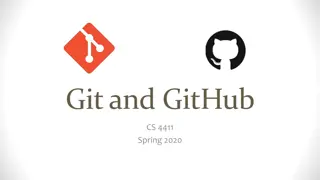Understanding Version Control Systems and Git Basics
Learning about version control systems like git is crucial for managing source code efficiently in multi-file, multi-person projects. Git allows for reliable backup, managing concurrent changes, and retrieving previous versions. Explore the basics of git, including repositories, committing changes, sharing updates, and more to streamline collaboration in software development.
Download Presentation

Please find below an Image/Link to download the presentation.
The content on the website is provided AS IS for your information and personal use only. It may not be sold, licensed, or shared on other websites without obtaining consent from the author. Download presentation by click this link. If you encounter any issues during the download, it is possible that the publisher has removed the file from their server.
E N D
Presentation Transcript
CSE 374 Programming Concepts & Tools Hal Perkins Fall 2015 Lecture 16 Version control and git
Where we are Learning tools and concepts relevant to multi-file, multi-person, multi-platform, multi-month projects Today: Managing source code Reliable backup of hard-to-replace information (i.e., sources) Tools for managing concurrent and potentially conflicting changes from multiple people Ability to retrieve previous versions Note: None of this has anything to do with code. Like make, version-control systems are typically not language-specific. Many people use version control systems for everything they do (code, papers, slides, letters, drawings, pictures, . . . ) Traditional systems were best at text files (comparing differences, etc.); newer ones work fine with others too But be sure to check before storing videos & other media 2
Version-control systems There are plenty: sccs, rcs, cvs (mostly historical); subversion, git, mercurial, perforce, sourcesafe, Terminology and commands aren t particularly standard, but once you know one, the others aren t difficult the basic concepts are the same svn still is widely used single central repository git and mercurial: distributed version control Same core ideas, but every user has a copy of the repository; allows easy branching & merging for large collaborations (e.g., linux kernel) We ll use git, which is very popular these days 3
What is git? If that doesn t fix it, git.txt contains the phone number of a friend of mine who understands git. Just wait through a few minutes of It s really pretty simple, just think of branches as ; and eventually you ll learn the commands that will fix everything. 4
Git basics general version A project lives in a repository Each user has their own copy of the repository A user commits changes to her copy to save them Other users can pull changes from that repository Alice Bob R R R Carol 5
Git basics central repo (well use) Users have a shared repository (called origin in the git literature, for cse374 it is your group s repository on the CSE GitLab server) Each user clones the repository Users commit changes to their local repository (clone) To share changes, push them to GitLab after verifying them locally Other users pull from Gitlab to get changes (instead of from each other) GitLab R R R R Carol Alice Bob 6
Tasks Learn the common cases; look up the uncommon ones. In a production shop using git Create a new repository/project (rare once or twice a year) a new branch (days to weeks; not in cse374, but used in production shops for independent development) a new commit (daily or more, each significant change) Push to repo regularly, when you want to back up or share work even with yourself on a different computer Other operations as needed (check version history, differences, ) 7
Repository access A repository can be: Local: specify repository directory root via a regular file path name url (file:///path...) Remote: lots of remote protocols supported (ssh, https, ) depending on repository configuration Specify user-id and machine Usually need gitand ssh installed locally Need authentication (use ssh key with GitLab) cse374/HW6 use ssh access to remote GitLab server Feel free to experiment with private, local repos or private repos on gitlab 8
Getting started (GitLab) Create local ssh keys (ssh keygen) and add to your GitLab account (won t have to type passwords once this is done & only need to do it once) Set up a repository (we ll do this for you on hw6; if you do it yourself you get to pick name, location) +New Project (on gitlab dashboard) Clone a working copy of the repo to your machine cd where-you-want-to-put-it git clone git@gitlab.cs.washington.edu:path/to/repo url for above comes from gitlab page for your project 9
Routine git/GitLab local use Edit a file, say stuff.c Add file(s) to set to be saved in repo on next commit git add stuff.c Commit all added changes git commit m reason/summary for commit Repeat locally until you want to push accumulated commits to GitLab server to share with partner or for backup 10
git/GitLab use (sharing changes) Good practice grab any changes on server not yet in local repo git pull Also do this any time you want to merge changes pushed by your partner Test, make any needed changes, do git add / git commit to get everything cleaned up locally When ready, push accumulated changes to server git push If push blocks because there are newer changes on server, do a git pull, accept any merge messages, cleanup, add/commit/push again 11
File rename/move/delete Once files have been committed to gitlab repository, need to tell git about any changes desired to git- managed files git mv files git rm files git will make the changes locally then make corresponding changes to remote GitLab repo when you push If you use regular shell mv/rm commands, git will give you all sorts of interesting messages when you run git status and you will have to clean up 12
Demo 13
Some examples Update local copy to match GitLab copy git pull Make changes git add file.c git mv oldfile.c newfile.c git rm obsolete.c Commit changes to local repo git commit m fixed bug in getmem Examine changes git status (see uncommitted changed files, will also show you how to revert changes, etc.) git diff (see uncommitted changes in files) git log (see history of commits) Update GitLab copy to reflect local changes git push 14
Conflicts This all works great if there is one working copy. But if two users make changes to their own local copies, the two versions must be merged git will merge automatically when you do a git pull Usually successful if different lines or different files changed If git can t automatically merge, you need to fix manually git will tell you which files have conflicts (git status) Look in files, you will see things like <<<<<<<< HEAD for (int i=0; i<10; i++) =============== for (int i=0; i<=10; i++) >>>>>>>> master Change these lines to what you actually want, then add/commit the changes (and push if you want to) 15
git gotchas Do not forget to add/commit/push files or your group members will be very unhappy Keep in the repository exactly (and only) what you need to build the application! Yes: foo.c foo.h Makefile No: foo.o a.out foo.c~ You don t want versions of .o files etc.: Replaceable things have no value They change a lot when .c files change a little Developers on other machines can t use them A simple .gitignore file can be used to tell git which sorts of files should not be tracked (*.o, *~, .DS_Store (OS X) ) Goes in top-level repo directory; useful to push to GitLab and share 16
Summary Another tool for letting the computer do what it s good at: Much better than manually emailing files, adding dates to filenames, etc. Managing versions, storing the differences Keeping source-code safe Preventing concurrent access, detecting conflicts git/Gitlab tutorial for CSE 374 on website Links to GitLab on website and in CSE 374 tutorial Full git docs and book are online, free, downloadable Beware of complexity much of what they describe is beyond what we need for CSE 374; keep it simple 17























